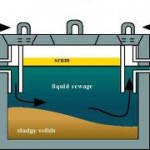Understanding Your Septic Tank – Information on the construction, operation and maintenance of your rural homes septic tank system.
 The septic tank is buried, watertight container typically made of concrete, fiberglass, or polyethylene. It holds the wastewater long enough to allow solids to settle out, forming sludge, and oil and grease to float to the surface as scum. It also allows partial decompositions of the solid materials. Compartments and a T-shaped outlet in the septic tank prevent the sludge and scum from leaving the tank and traveling into the leach field area.The most common leach field consists of a series of trenches containing perforated pipe surrounded by septic rock, or gravel, and covered with mesh and dirt. The effluent entering the leach field is partially absorbed into the soil and partially evaporated. the leach field should not be driven on or covered by a driveway or patio.
The septic tank is buried, watertight container typically made of concrete, fiberglass, or polyethylene. It holds the wastewater long enough to allow solids to settle out, forming sludge, and oil and grease to float to the surface as scum. It also allows partial decompositions of the solid materials. Compartments and a T-shaped outlet in the septic tank prevent the sludge and scum from leaving the tank and traveling into the leach field area.The most common leach field consists of a series of trenches containing perforated pipe surrounded by septic rock, or gravel, and covered with mesh and dirt. The effluent entering the leach field is partially absorbed into the soil and partially evaporated. the leach field should not be driven on or covered by a driveway or patio.
If your home‘s plumbing system does include an on-site septic system, it is incredibly important to be aware of the signs of possible damage, along with the maintenance needed to prevent it. A damaged or clogged septic system can be costly to repair. It can also impose possible health risks for homeowners, tenants and neighbors. A failing septic system could be responsible for releasing wastewater and harmful bacteria and viruses, including E. coli.
There are many different types of septic systems ranging from what are called conventional in-ground systems to sand mounds and from spray irrigation systems to stream discharge systems. There are also seepage pits, cesspools, and homemade systems. This booklet is not intended to cover every situation, but is intended to give the homeowner an understanding of the concept of how a septic system works and a better understanding of a septic inspection.
The in-ground type of septic system uses a series of perforated pipes located below the ground surface. These pipes are placed in a bed of crushed stone or aggregate. The sewage flows over the crushed stone or aggregate into the underlying soil. The condition of this soil determines how well your septic system will operate and how large the absorption area needs to be. If the absorption area is too small and the soil is too tight as with clay soils, the liquid cannot soak into the soil fast enough causing the waste to either back up into the home or emerge at the ground surface. An early sign of waste emerging at the surface is “lush growth.” The saying “that the grass is always greener over the septic tank” isn’t true when it comes to a properly operating septic system.
How often should a septic tank be cleaned or pumped? The frequency for pumping a septic system depends on a number of factors; the average frequency is between two and four years. You can, in some cases, abuse a septic system and neglect to pump it for 10 or 20 years without any apparent problem. This would be like driving your automobile for 50,000 miles without changing the oil. You might get away with it, but you would certainly cause undue wear and tear on the engine. The same is true with a septic system. You may get away with not pumping the system for many years, but you will pay for it in the end by having to replace the absorption area.
When the soil conditions are right, an area of active microorganisms is formed where the waste enters the soil. As the waste slowly percolates through the soil the microorganisms continue to grow and feed on the harmful bacteria and viruses in the septic waste. The underlying soil continues to absorb and filter the waste. Four feet of soil is all that is needed to treat the septic waste in good soil conditions.

Recent Comments